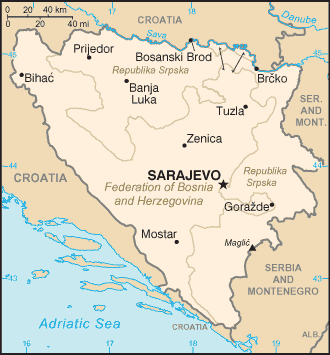Geography of Bosnia and Herzegovina
|
|
Location: Southeastern Europe, bordering the Adriatic Sea and Croatia.
Geographic coordinates: Template:Coor d
Map references: Bosnia and Herzegovina, Europe
Area:
total:
51,129 kmē
land:
51,129 kmē
water:
0 kmē
Area - comparative: slightly smaller than West Virginia
Land boundaries:
total:
1,459 km
border countries:
Croatia 932 km, Serbia and Montenegro 527 km (312 km with Serbia, 215 km with Montenegro)
Coastline: 23 km
Maritime claims: NA
Climate: hot summers and cold winters; areas of high elevation have short, cool summers and long, severe winters; mild, rainy winters along coast
Terrain: mountains and valleys
Elevation extremes:
lowest point:
Adriatic Sea 0 m
highest point:
Maglic 2,386 m
Natural resources: coal, iron, bauxite, manganese, forests, copper, chromium, lead, zinc, hydropower
Land use:
arable land:
14%
permanent crops:
5%
permanent pastures:
20%
forests and woodland:
39%
other:
22% (1993 est.)
Irrigated land: 20 kmē (1993 est.)
Natural hazards: destructive earthquakes
Environment - current issues: air pollution from metallurgical plants; sites for disposing of urban waste are limited; widespread casualties, water shortages, and destruction of infrastructure because of the 1992-95 civil strife
Environment - international agreements:
party to:
Air Pollution, Law of the Sea, Marine Dumping, Marine Life Conservation, Nuclear Test Ban, Ozone Layer Protection
signed, but not ratified:
none of the selected agreements

